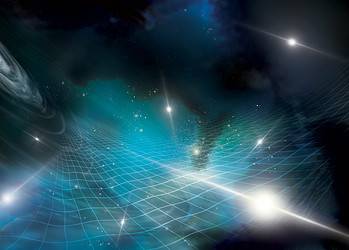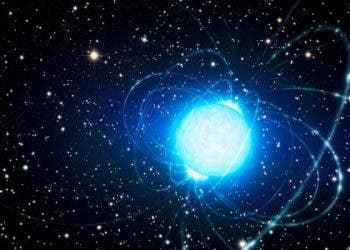Gravitational waves are disturbances in space-time generated by some of the largest and most energetic events in the universe. They propagate as waves from a source at the speed of light.

In Einstein’s general theory of relativity, gravity is considered a curvature of spacetime — a curvature caused by the presence of mass. The larger and more compact the mass is, the greater the curvature. For physicists, gravitational waves are also the wave-like solution of Einstein’s equations and the only way through which some phenomena in the universe can be observed.
For instance, when the orbits of two massive bodies change over time, this seemingly results in a loss of energy. But energy can’t be lost, so it must go somewhere — and the only way to explain that loss is that the energy is used to produce waves in space-time, emitting gravitational radiation.
The theory lined up well, but there was a problem: for decades, researchers couldn’t truly detect these gravitational waves, and without validation, the theory couldn’t be confirmed. That all changed in 2015, with the first gravitational waves (GW150914) being directly observed by the two Laser Interferometer Gravitational Wave Observatory (LIGO) detectors. Three years later, the three main scientists behind the detection received the Nobel Prize for the discovery. But researchers may have discovered gravitational waves way earlier, in 1982.
Hulse–Taylor binary

In 1974, two astrophysicists, (Russell Alan Hulse and Joseph Hooton Taylor Jr) were carrying out a pulsar survey at the Arecibo Observatory, a radio telescope with a 305 meter (1,000 ft) dome. You may remember Arecibo as that big telescope that collapsed to rubble in late 2020 due to underfunding and neglect. Pulsars are a type of compact stars that emit radio or X-ray radiation — they’re a sort of cosmic lighthouse that spins, and whenever it emits a signal towards the Earth, we can detect.
There’s an important reason why Arecibo was so big. The goal of radio telescopes is to detect radio waves — waves for which the wavelength can measure even more than the Earth’s radius. The sources of radio waves outside the solar system are really weak, so we need very big dishes to detect those objects — and Arecibo successfully detected something.
The scientists detected a ‘weird’ pulsar, later named PSR B1913+16 or the “Hulse-Taylor binary”. Researchers noticed that the pulsation period of this pulsar is not stable — it changes and returns to the original state every 7.75 hours. The only explanation for that change was that the pulsar is in a binary system, the pulsar was completing an orbit every 7.75 hours. They knew that thanks to the Doppler effect.
When a light source is moving away from us, its frequency is shifted to the red side of the visible spectrum — and when it moves towards us it is shifted to blue. By measuring the pulsar period, Taylor and Hulse were able to plot a velocity curve to help analyze the orbit and try to figure out who was the pulsar’s companion.

In their analysis, they observed that system does not have a circular orbit but an ellipse. In the end, they concluded the pulsar lived in a binary system with another compact star, but they could yet not conclude if it was also pulsar or not.
Gravitational waves
By now, you’re probably wondering what this all has to do with gravitational waves. We’re almost there.
Eight years later, without stopping the observations, Taylor and Joel M. Weisberg realized the orbital velocity was increasing, meaning the stars were accelerating. They had also improved their knowledge of the system and figured that both stars have nearly the same mass of 1.4 solar masses and that their orbit is tight, around 4.5 times the Sun’s radius (or 9 times the distance from the Earth to the Moon). The pulsar’s companion is probably another pulsar, they concluded, but we just cannot get its radio signal because the beams it emits are never pointed towards Earth.
The binary was the perfect candidate to test the gravitational waves solution to Einstein’s equations, but because we couldn’t get direct information from the waves themselves, Taylor and Weisberg used theory to indirectly connect the observations from the pulse’s period. They noticed that the orbital period between the stars was decreasing with time, which means it was losing energy — presumably to gravitational waves.
While Arecibo was still working, the observations continued, and 30 years later, the same theory continued to fit the estimated loss of the orbital period, hinting more and more that the binary is emitting gravitational waves. The jaw-dropping conclusion of the study is the almost perfect agreement between the points (in red below) and the theory (blue line) almost as if there isn’t a minimal mistake in Einstein’s theory. Although they didn’t have any direct observation, astronomers had most likely detected gravitational waves indirectly.

The discovery of the binary pulsar resulted in a Nobel prize in 1993 for Taylor and Hulse, but not for the gravitational waves indirect detection. PSR1913+16 has always been the observation that paved the way for the gravitational waves interferometer, with the binary it was almost certain that the theory was correct, scientists just needed to be lucky enough to observe the phenomenon. It happened and in 2017, the Nobel prize in physics was awarded to LIGO researchers for the first solid detection.

The Arecibo radio telescope collapsed a year ago. The iconic telescope that made the first detection of binary pulsars, and many others, fell to rubble as it struggled to obtain funding in recent years. The data collected by the telescope is still used by scientists, the most recent was published exactly one year after its collapse, the research tries to understand the history of galaxies with their stellar mass.






